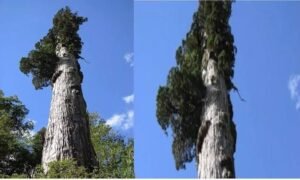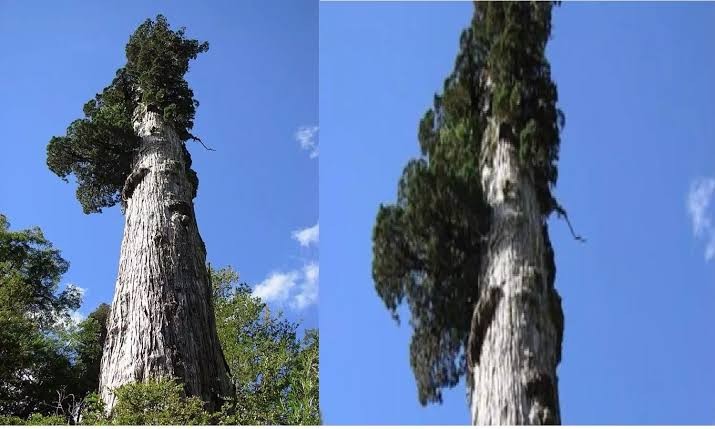When one explores the complex history of our planet, old arboreal sentinels serve as mute witnesses to the passage of time. With their worn bark and gnarled branches, the oldest trees in different regions of the world resemble ancient sentinels. These living histories offer a window into the everlasting endurance of nature, from the towering Baobabs of Africa to the ancient Bristlecone Pines of North America. We go into the very roots of the past of our planet as we set out on a quest to discover the mysteries kept by these ancient giants.
The oldest trees in different regions of the world call out to us with murmurs that reverberate through time and entice us to decipher the tales engraved in their rings. Come along for an investigation of the history of trees, where every branch and leaf turns into a page and the collective canopy narrates the epic story of the oldest trees in different regions of the World.

Quick Navigation
How do scientists establish the ages of the oldest trees in different areas?
It takes a wonderful fusion of scientific disciplines to understand the age of the oldest trees in different places. Dendrochronology, an approach based on tree rings, is essential to this endeavor. Scientists can identify trends in growth and environmental circumstances throughout time by carefully analyzing the growth rings of trees. They can accurately count the annual rings thanks to this technique, which yields a trustworthy age estimate for the tree. In areas where dendrochronology may not be as useful, radiocarbon dating is used. Through the analysis of carbon isotope levels in the tree’s tissues, scientists are able to determine the age of the tree with remarkable precision.
What aspects of the surrounding environment support the longevity of these old trees?
A careful balancing act with environmental elements is responsible for the longevity of the oldest trees in different regions of the world. The climate in each of their distinct locations is a major factor. Bristlecone pines and other similar trees grow slowly in arid, hostile environments, which is a monument to their tenacity. Another important factor is the condition of the soil; well-drained soils inhibit root infections and promote nutrient uptake. Moreover, their continued expansion is facilitated by the lack of natural predators. These ancient trees can carry on their slow and steady trip through time in settings where there are few risks.
Are the oldest trees in different places associated with any particular cultural or spiritual significance?
The oldest trees in different regions of the world are frequently extremely significant culturally and spiritually, in addition to being biological marvels. These ancient giants represent a link between the divine and the earthly sphere and are held in high regard in many indigenous cultures.
Certain trees are included in the oral traditions of indigenous cultures as living witnesses to the past. These ancient trees come to represent tenacity, knowledge, and the eternal spirit of the natural world. Rituals carried out in the presence of these venerable sentinels are frequently a part of spiritual activities, which strengthen the bond between human societies and their arboreal elders.
What impact has human activities had on these old arboreal marvels’ ability to survive?
The preservation of the oldest trees in different regions of the world has unfortunately become a double-edged sword due to human activities. These trees have withstood ages of natural adversity, but they are currently facing enormous dangers from human activity. Their habitats are invaded by urbanization, deforestation, and land development, which causes habitat loss and fragmentation. Air and soil pollution present additional difficulties.
The fragile ecosystems on which these trees depend can also be upset by invasive species that humans have brought into the area. Maintaining these historic treasures requires balancing modern demands with preservation efforts. Only then can their survival be guaranteed.
Read Also: École polytechnique fédérale de Lausanne | History, Admission, Programs
What problems do these ancient trees have in the present day?
A variety of contemporary issues threaten the survival of the oldest trees in different regions of the world. The sensitive equilibrium that these trees have spent ages adapting to may be upset by changes in temperature and precipitation patterns brought about by climate change, which poses a serious threat. Their survival is directly threatened by the increased frequency and intensity of wildfires, which are frequently made worse by human activity.
These old giants are also weakened by pollution, both soil- and air-based, making them more susceptible to illness. In order to ensure that the oldest trees on Earth survive into the future, conservation initiatives must tackle these modern issues.
Is it feasible to visit these trees sustainably, and are there any conservation initiatives in place to safeguard them?
Sustainable visitor methods are necessary to strike a balance between the urge to explore and the need to protect the oldest trees in different regions of the world. By establishing well-thought-out ecotourism programs, lovers can enjoy the grandeur of these old trees without endangering their health. To reduce human effect, conservation initiatives frequently entail the establishment of rigorous restrictions and protected areas.
The goal of cooperative programs involving governments, local communities, and environmental organizations is to increase public awareness of the value of protecting these arboreal treasures. We can help ensure the continued preservation of these living treasures by encouraging tourists to take responsibility for their actions and by putting sustainable tourism principles into effect.
Additionally: Oldest Trees In Different Regions Of The World
As living reminders of the passage of time, the oldest trees in different regions of the world. Their antiquity is revealed by scientific techniques like radiocarbon dating and dendrochronology, but their presence is complicated by cultural importance, environmental influences, and modern-day difficulties. These historic arboreal treasures are largely preserved by the positive and negative acts of humans.
A healthy equilibrium that guarantees the longevity of these ancient trees’ silent yet potent presence on Earth arises as we negotiate the complex interaction between ourselves and them. We are invited to be custodians of their legacy and pave the way for sustainable coexistence by the oldest trees in different regions of the world.

Tree-Dwelling Chronologists: An Overview of Dendrochronology
Dendrochronology is one of the amazing techniques used by scientists to determine the ages of the oldest trees in different areas. Through the study of tree rings, this complex science provides information about changes in the climate, growth patterns, and environmental circumstances. Consider the Methuselah tree, a Bristlecone Pine that grows in California’s White Mountains. After carefully counting its rings, dendrochronologists discovered that the tree is over 4,800 years old, making it the oldest non-clonal tree on Earth.
Environmental Factors Shaping Longevity: Nature’s Architects
The environmental conditions of these ancient arboreal wonders’ habitats have a significant impact on how long they live. Think about Madagascar’s giants, the Baobabs, who resemble fanciful creatures. Because of their enormous trunks’ capacity to store water, they can withstand extended droughts and thrive in arid environments. Another important factor is the makeup of the soil; well-drained soils encourage strong root systems and efficient nutrient absorption. The World’s Oldest Trees demonstrate how nature may shape resilience over millennia by adapting to a variety of climates.
Read ALso: What Is A Sleep and Wake Up Light
Roots Intertwined with Culture: Spiritual and Cultural Importance
These ancient trees are marvels of biology, but they also have deep cultural and spiritual importance. The ancient Gedeo people of Ethiopia revere the centuries-old Juniper trees that grow in the Harenna Forest. These tree-dwelling elders are essential to community rituals because they represent a bridge between the material and spiritual worlds.
Africa’s Baobabs are gathering places for locals, with their massive trunks acting as backdrops for customs and old stories. Not only are the Oldest Trees in Different Parts of the World treasured players in the cultural narratives of the people who coexist with them, but they are also historical witnesses.
The Effect of Human Footprints on Preservation
Even though these extinct giants have withstood the test of time, human activity threatens to keep them preserved. The Amazon Rainforest, which is home to a wide variety of ancient trees, is rapidly losing its forest cover due to agricultural growth. The massive California Redwoods have seen logging operations that have drastically reduced their formerly vast ranges.
Urbanization, pollution, and the arrival of alien species exacerbate the difficulties these old protectors face. A careful balance between human demands and the need to preserve these living treasures is needed to preserve the oldest trees in various parts of the world.
Read Also: 15 Best 6 Months Certificate Courses in Canada 2024
Modern Difficulties: Getting Around in a Changing World
These ancient trees face unheard-of difficulties in the present world. With its effects on ecosystems and changed patterns of temperature, climate change is particularly dangerous. More wildfires are endangering iconic trees like gigantic sequoias, driving them to the verge of extinction. Their resistance to disease is weakened by pollution, both airborne and soil-based. The World’s Oldest Trees are at a crossroads, needing to adapt to a fast changing global environment through creative conservation strategies.
Sustainable Investigation: Is It Possible to Combine Conservation with Tree-Visiting?
Ecotourism initiatives have emerged in response to the attraction of seeing The Oldest Trees in many parts of the world, with the goal of offering a sustainable means of exploration. This delicate equilibrium is best shown by the majestic sequoias of Sequoia National Park. To lessen their influence on the delicate ecosystems surrounding these old giants, visitors are urged to stick to the approved trails. Informed by conservation efforts, sustainable tourism techniques aim to preserve these living riches while enabling connoisseurs to responsibly take in their majesty.

Conservation Initiatives: Combining Worldwide Efforts
Global cooperation is needed to preserve the oldest trees in various parts of the world. The goal of organizations like the Ancient Tree Forum in the UK is to locate, catalog, and preserve ancient trees. Raising awareness of the ecological significance of ancient Tasmanian trees is the main goal of the Australian project Tarkine Forest Adventures. Governments, environmental organizations, and local communities are working together to create protected areas and enforce laws that will conserve these amazing trees.
The Quiet Call to Stewardship: A Joint Obligation
The World’s Oldest Trees invite people to take on the responsibility of protecting their cultural heritage. It is a reminder that all life on Earth is intertwined and that we should treat the fragile ecosystems that sustain these venerable protectors with care. The preservation of these living wonders for future generations requires conservation efforts to cross national boundaries as well as cultural and geographic divisions.
Recommended:
- Swiss Federal Institute of Technology (ETH Zurich) | History, Admission, Total Review
- University College Lillebaelt – Total Review, History, Admission & Programs
- 7 Top Christian Universities in the USA
- 100 Free Online Courses In Canada With Certificates
A Peaceful Future: Living with the Elders of Nature
As we take in the beauty of The Oldest Trees in Various Parts of the World, let us remember the lessons trees teach us. They are live examples of adaptability, resiliency, and the deep connection that exists between all living things rather than just being objects of observation. We can create a peaceful future where these ancient trees flourish and continue to awe and revere future generations by adopting sustainable practices, supporting conservation efforts, and fostering a feeling of responsibility.
The Oldest Trees in Different Regions of the World play a timeless tune in the grand symphony of nature, serving as a constant reminder of our common journey throughout the globe and the necessity of protecting the wonders that have been witness to the epochs of Earth’s history.
SEE ALSO:
Trust you found our article on Oldest Trees In Different Regions Of The World helpful. Follow our website for more interesting articles.

